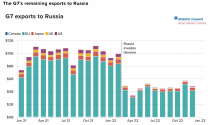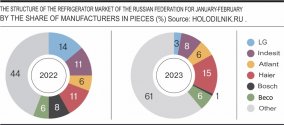You are using an out of date browser. It may not display this or other websites correctly.
You should upgrade or use an alternative browser.
You should upgrade or use an alternative browser.
Russia Economy Thread
- Thread starter NiuBiDaRen
- Start date
Its long interview about Solar production in Russia. They thing there Solar panels already among top.
the key thing is solar has alot of science behind it to produce a product that survive environment for 30 to 40 years. and that scientific potential has other uses. The plant is built near the Lithium battery plant. so presumably workers can alternate if one of production goes down.
the key thing is solar has alot of science behind it to produce a product that survive environment for 30 to 40 years. and that scientific potential has other uses. The plant is built near the Lithium battery plant. so presumably workers can alternate if one of production goes down.
CM. “Technological sovereignty is of fundamental importance now. Hence the next question. How independent is the production of solar cells in Russia – in terms of technologies, materials and components? How can we make our solar production independent of those who today consider themselves monopolists?
I.Sh. – You are right, in modern conditions it is very important. It is in order to reduce the dependence of Russian renewable energy on imported raw materials and materials that we are building our own production of silicon wafers and solar cells. There are also plans to localize the production of polysilicon.
The development of solar energy has already provided the emergence in Russia of such related industries as solar cable, grid inverters, silver-coated busbars, conductive silver paste, provided additional capacity for manufacturers of glass, copper wire, etc.
It is important to understand the entire production chain here. At the head of everything is quartzite. We have quartzite mines in Russia, for example, in Buryatia - Cheremshansky quartzite. Metallurgical silicon is produced from it, with a quality of 3-4 nines. We have two silicon plants, in Siberia and in the Urals. From this silicon, polysilicon is produced using various technologies, from which, in turn, monosilicon is produced. This is exactly the product that is needed for the production of solar cells. Ingots are produced according to the Czochralski method, these ingots are cut into plates, and photovoltaic cells are made from the plates. The cell is connected to a conductive bus and encapsulated in a module. Well, then solar modules, as well as inverters, transformers, solar trackers and SNEs are connected in a “solar park”. Here's the entire chain
Let's clarify what we already have if we are talking about technological sovereignty.
In Russia, there is metallurgical silicon, there is the production of plates, cells, modules, and electrical equipment. Perhaps there are no tracker systems yet. The production of solar glass is gradually developing - there are two types of them - rear and front. The rear glass is necessary to obtain an anti-reflection effect and generate energy reflected from snow, sand, depending on where the module is located.
From the main there is no polysilicon in industrial volumes. It is necessary to build a plant for the production of polysilicon with a capacity of at least 10,000 tons. In order, firstly, the plant pays off, and secondly, it is needed for our domestic Russian consumption. Now approximately 70% of all polysilicon is produced in China, as well as in Germany, the USA, and Korea. At the current stage, we are forced to buy polysilicon in foreign markets.
CM. – A new ENKOR plant is being built in the Kaliningrad region. Why there? Is it done with the expectation of foreign markets? But now, so far, the geopolitical and foreign trade situation is not very favorable, and I suspect that there may be logistical difficulties with the supply of raw materials to this production facility. How do you assess these risks?
I.Sh. – The Kaliningrad region is a dynamically developing region with attractive conditions for investors. In the same place, in fact, our colleagues are building the RENERA plant.
MOSCOW, May 5. /TASS/. Traffic on the second railway track of the Crimean Bridge is open, Deputy Prime Minister Marat Khusnullin said on his Telegram channel.
...
"Today, traffic has opened on the second railway track of the Crimean Bridge. This was no small feat for construction workers, restoring this important facility. Thanks to their dedicated work, the automobile part of the bridge was fully opened in February a month and a half ahead of schedule. Now we have launched traffic on the second track of the railway part - also ahead of schedule," he said.
...
"Today, traffic has opened on the second railway track of the Crimean Bridge. This was no small feat for construction workers, restoring this important facility. Thanks to their dedicated work, the automobile part of the bridge was fully opened in February a month and a half ahead of schedule. Now we have launched traffic on the second track of the railway part - also ahead of schedule," he said.
Turkish construction firms have huge contribution to Russia. so its logical.
It says increase diversify flights to increase tourism between Russia and Iran but i think Russia want wider access to society to attract people. Russia have skill shortage.
Azerbaijan double the order of long haul than initially intended. this give idea how the whole region is changing due to Ukraine conflict. not even Turkish airline is enough.
It says increase diversify flights to increase tourism between Russia and Iran but i think Russia want wider access to society to attract people. Russia have skill shortage.
Azerbaijan double the order of long haul than initially intended. this give idea how the whole region is changing due to Ukraine conflict. not even Turkish airline is enough.
This short video is about opening a bank branch in Yalta, Crimea but what it really shows many kids in front of a mall. certain things need to be practically seen to believe on statistics. This is still not a tourist season and this not really a tourist place. so it shows local demographics. when people have reasonable wealth they can have family. and this certainly not a organize show. There is giant poster also.
Russia’s Ozon Retailer Finds Huge Online Sales Market In China
November 30, 2022Market is booming for Russian retailers able to handle Chinese goods
Ozon, one of Russia’s largest online retailers, has opened an office in Shenzhen, in South China near to Hong Kong, as the demand for Chinese products in Russia keeps growing.
From home appliances, laptops and smartphones to clothing and daily necessities, a wide range of Chinese products sold at the Ozon online store fills gaps due to the pull-out of Western companies after the breakout of the Russia-Ukraine crisis. This development adds a new trade development between China and Russia in bulk commodities and means that bilateral trade will become more complementary and diversified.
...
Ozon Global, a division of Ozon, opened an office in Shenzhen as its Chinese headquarters to boost cross-border sales to Russian shoppers on its platform. Ozon’s China Managing Director said the company plans to attract at least 100,000 Chinese sellers to the platform by 2024, and to elevate the gross merchandise volume (GMV) of Chinese vendors by 10 times by 2026. The company already has more than 10,000 active Chinese sellers.
Chinese products now account for 90% of Ozon’s cross-border trade. According to Ozon China, the sales of Chinese products soared in the second and third quarters of 2022, rocketing about 25 times compared with the same period last year, and the number of active Chinese sellers rose 18 times, reaffirming Ozon’s decision to expand to Chinese market.
“Ozon opened access for international sellers two years ago, but Chinese sellers only started entering last year. This year, the growth is brisk” the company said, adding that there is surging demand for Chinese products in Russia, because China – as a manufacturing powerhouse – “has rich products and appealing price advantages.” according to its Weibo account.
...
Cai Jun, vice president of international business of Beijing Puppy Vacuum Cleaner Group Co, has stated that the company set up a store on Ozon in the first half of 2022, and home appliances such as vacuum cleaners manufactured by the company have been “quite popular,” witnessing 20-30% monthly growth in sales.
...
Ozon supports payments in Chinese Yuan, which is convenient for Chinese sellers and reduces potential risks associated with exchange rate fluctuations.
...
This is the vehicle that will be tested in China to reduce the development time. They are expecting mass production some time in 2025. They are expecting comfort level of C or D segment in this size. Price between Model 3 and VW Polo. Kaspersky OS is operating system that they expect to share with other manufacturers. Atom name is due to supply of batteries, electric system from Rosatom.









